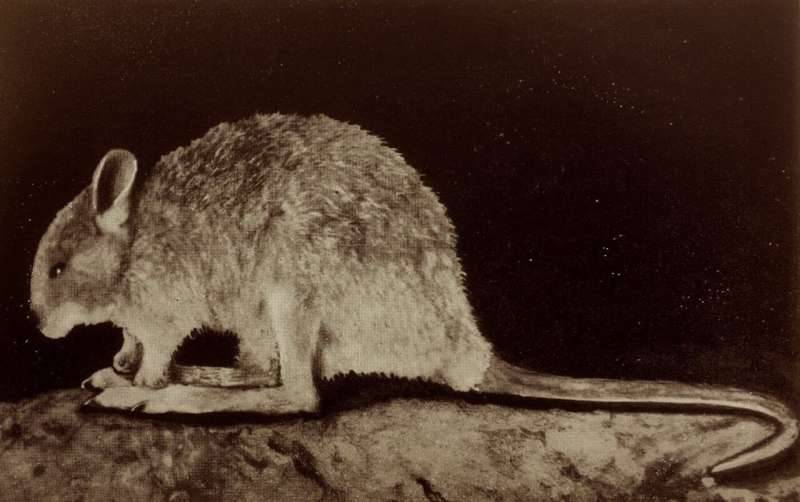This article has been reviewed according to Science X's editorial process and policies. Editors have highlighted the following attributes while ensuring the content's credibility:
fact-checked
peer-reviewed publication
trusted source
proofread
Desert rat-kangaroo's diet offers clues to its possible survival in remote Australia

An intriguing native Australian rat-kangaroo, thought to be probably extinct, may still be running around in the inhospitable remote Sturt Stony Desert—and Flinders University researchers have discovered new details about its feeding habits that might help find it.
The experts in marsupial evolution and ecology have compared the biting ability of different small animal skulls to understand the kinds of food the desert rat-kangaroo ate, thus narrowing down the best areas to monitor for the little animal.
"Rat-kangaroos like bettongs and potoroos are an ideal group of animals for testing skull biomechanics because they each have differently shaped skulls and specialize in very different food groups," says Dr. Rex Mitchell, lead author of a new article published in the Journal of Experimental Biology.
"We were surprised to find the heftier skull of the desert rat-kangaroo isn't necessarily adapted for biting into harder foods. When we included the animal's smaller size into the analysis, the robust features of the desert rat-kangaroo's skull were only found to be effective enough to handle eating a softer range of foods."
The latest research could help efforts to "rediscover" the desert rat-kangaroo, known as "ngudlukanta" to the traditional custodians of that Country, the Wangkangurru Yarluyandi people, particularly after unsubstantiated reports of a distinctively small, short-faced, hopping animal in the vicinity of their home range in the Lake Eyre Basin in remote far north-east South Australia into adjacent Queensland.
Predation by foxes and cats and competition with rabbits, overstocking with cattle and sheep, and poor fire management have pushed it to extinction. The small desert-dwelling potoroid marsupial is now known from only a handful of museum specimens that were gathered in inaccessible areas of South Australia.
The small marsupial was declared extinct in 1994 after the last specimen was collected in 1930, but monitoring for the rare animal continues.
"It is plausible that a small, nocturnal species could be evading detection in the vast inland desert. In fact, this species was previously a resurrected 'Lazarus' species after its rediscovery in the 1930s," says senior author of the study, Associate Professor Weisbecker.
"So regardless of whether or not the species persists in the Sturt Stony Desert or elsewhere, the story of the desert rat-kangaroo serves as an ongoing reminder that extinction declarations might not always be the end of the story."
This new-found evidence of its feeding habits could help to focus search efforts on specific regions where these plants grow.
The desert rat-kangaroo was known to eat mostly leaves of plants, but its short round face led previous researchers to suggest that it could eat harder foods as well if needed, such as seeds and twigs.
"Finetuning the search through understanding the animals' diet better might just resurrect the little desert survivor once more," adds Dr. Mitchell.
Using computer models of historic skeleton specimens, the new study uses a method called Finite Element Analysis (FEA) to test the skull's ability to handle the forces that happen during biting.
The skull of the desert rat-kangaroo was compared with the skulls of short-faced specialists of harder foods like the burrowing bettong, or boodie, and the specialists of softer fungi like the long-nosed potoroo.
The researchers say these kinds of studies give valuable insights into the relationship between skull shape and biting ability, with applications toward animal behavior, conservation, ecology, evolution and paleontology.
More information: D. Rex Mitchell et al, Testing hypotheses of skull function with comparative finite element analysis: three methods reveal contrasting results, Journal of Experimental Biology (2025). DOI: 10.1242/jeb.249747
Journal information: Journal of Experimental Biology
Provided by Flinders University



















